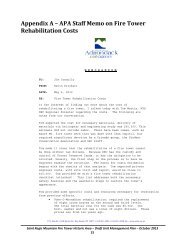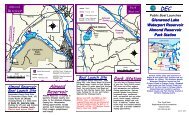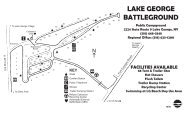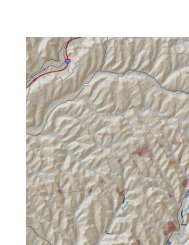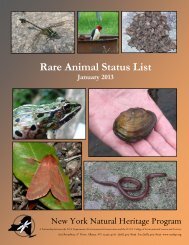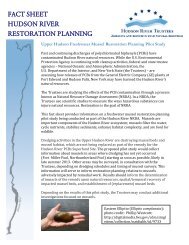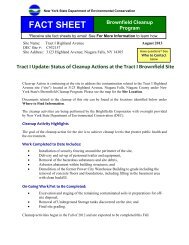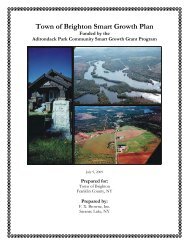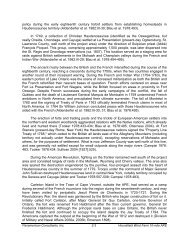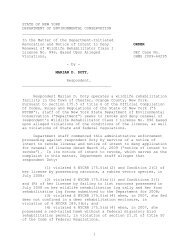a UNIVERSAL RESOURCES HOLDINGS, INC. - New York State ...
a UNIVERSAL RESOURCES HOLDINGS, INC. - New York State ...
a UNIVERSAL RESOURCES HOLDINGS, INC. - New York State ...
You also want an ePaper? Increase the reach of your titles
YUMPU automatically turns print PDFs into web optimized ePapers that Google loves.
LF Coraents bv Rolland E. Kidder. -. President<br />
Kidder Exvloration. Inc.<br />
Hearing on the Diaft ~nv1;onmentsl Inpact <strong>State</strong>ment<br />
Held by the <strong>New</strong> <strong>York</strong> <strong>State</strong> Department<br />
of Environmental Conservation 1<br />
Juestovn. NY, June 15. 1988<br />
Kidder Exploration, Inc. is an indepeniient natural gas drilling<br />
company located here in Juestovn, NY. We are pleased that<br />
after uny years of work we nov have a Draft Enviro~ental Inpact<br />
<strong>State</strong>ment (DEIS) and hope that it, or a variation of it, will be<br />
adopted by the Department in the days ahead.<br />
The Nev <strong>York</strong> Independent Oil and Gas Association (IOCA) of vhich<br />
be are a aeaber created a special cornittee to deal with the<br />
technical aspects of this document. I would instead like to<br />
briefly comment on some overall policy matters which are<br />
reflected in this proposal.<br />
<strong>State</strong> Primacy on Regulation<br />
First of all, the DEIS recognizes that the Departrent of<br />
Environmental Conservation is to be the lead agency in regulating<br />
the oil and gas industry in <strong>New</strong> <strong>York</strong>. It is vital for the health<br />
of our induatry that state prLucy in the regulation of our<br />
industry continue.<br />
All ujor oil and gas producing states have provided statewide<br />
replation for this induatry. In Texas (tha largest oil and ges<br />
producing state) thi. regulatory control was given in the 1930's<br />
to the Texas Railroad Cairnsion. That Col.iasion was at that<br />
time the only ujor regulatory body in the state and regulation<br />
of the oil and gas business warn dsned necassary. In Nw Tort<br />
Stete that regulatory control ha* bsen given, more correctly, to<br />
an envirorucntal agency--the DEC. You control by the permit<br />
process not only the proper spacing of wells, but the proper<br />
environmental procedures for drilling and completing these vells.<br />
It is absolutely essential that in this day and age of more and<br />
more laws end regulations being imposed by more and more<br />
#overmental agencies--that thare be one agency responsible for<br />
the regulation and control of oil and gas drilling. The<br />
"8slkanization" of governmental control vould bring to a<br />
screeching halt an industry that is already reeling from the<br />
worst economics it has seen since World War 11.<br />
-Rec~L 9-7
KEI-2<br />
If anyone wonders exactly hw uny conaiderations are involved in<br />
granting a permit--I vould refer than to page 8-3 of the DEIS. I<br />
count thirteen and that probably doesn't include everything. This<br />
illuatratea why it la bparative that producers be able to work<br />
with one governmental agancy uhen it comes to drilling permits.<br />
In two areas of the DEIS, I A<br />
lead agency status.<br />
d rec-end an improvement in the<br />
(1) Hirtoric and Arch8eoloaical Determinations:<br />
The law nw requires the Ww <strong>York</strong> <strong>State</strong> Department of Parkr and.<br />
Recreation to deterrine whether or not a site is of archaologic'<br />
or historic intereat. If such a determination is ude, a<br />
p~ducer mat conduct a study that uauelly costs $1.000-$1,500 to<br />
dqlate. Mora serious; however. are theLdelays that can occur<br />
in the process of waiting for approval. Wa wuld recomead that<br />
soma type of interagency sgrauent be entered into between the<br />
DEC and Parks and Recreation in order to let the Divlsion of<br />
Mnarals act as the agent for approval or disapproval of historic<br />
and archaeological pemita. We would alao recomend that the map<br />
(Loam as the so-called "bone up") be lmproved so that it is<br />
Pore site spacific; and that it ba revlmed frm tiu-to-the when<br />
historic artifacts are not discovered after a digging study has<br />
baen corplated.<br />
(2) Secondly, we would recomend that within the DEC<br />
procedures ba altered so that wetland determinations can be coordinated<br />
through the Division of Wnarals. Although the<br />
experience vith delay has not baen a major problem, we beliava it<br />
wuld uka .ore sense to have a one-stop-ahoppiog approach<br />
uhareby ua could subdt our wetland permlt applicationa to the<br />
Division of Uerals along with our other pellit raquesta.<br />
Balmcing the Interests<br />
Our other general cwnt on the DBIS. focusaa on the area of the<br />
"balanciq of intereetn." Wa believe that overall the documsat<br />
doer tbt and takes into coneideration the urltitude of<br />
enviroluntal concern* the Departlent must deal with ae wall as<br />
racogniring the realities we as businessmen mat live with in<br />
drilling for oil and natural gar. That balance st be continued.<br />
For axupla, therm is the often misunderstood issue of brine<br />
disposal. Many people do not realize that oil and gas core from<br />
eadlmentary rocks deap in the earth that ware at one che<br />
associated vith urine *nviroruents. 400 million years ago<br />
Chautauqua County wea underwatar--salt water. The sedluntr of<br />
that envirowent--daltic and coastal barrier bar--are nov being<br />
drilled 4000 feat dovn. The decomposed fossil life from thoae<br />
ancient timer is trapped in the rock and we produce it as natural<br />
0.8.<br />
KEI-1 There has never been any question that the Department of Environmental<br />
Conservation will remain the lead agency for oil and gas regulation in the<br />
<strong>State</strong>. The Department's Division of Mineral Resources and the Office of<br />
Parks, Recreation, and Historic Preservation (OPRHP) worked together to<br />
establish special procedures for dealing with oil and gas drilling permit<br />
applications. These special procedures, which were implcmtntcd by OPRHP<br />
in 1984, resulted in shortening the average turnaround time for archeological<br />
reviews to a few days. It should be noted that a surwy of operaton<br />
conducted by the DMN in 1986 revealed that only a small number of<br />
operators who waited for determinations from OPRHP were actually required<br />
to conduct archeological investigations. Most companies who conducted<br />
, investigations did so of their own accord in order to avoid possible delays.<br />
As previously stated, OPRHP feels it is necessary to restrict access to their<br />
archeological maps. Modifications to these maps, and the archeological<br />
review requirements, are outside DECs jurisdiction.<br />
KEI-2 The Division of Mineral Resources does not have the necessary technical<br />
expertise to make wetland determinations. Whenever permits from different<br />
Divisions within the Department are required, the Division of Regulatory<br />
Affairs (DRA) is the designated coordinator.
Natural gas is the cleanest burning fuel in the world--it is<br />
absolutely non-polluting. However, as these rock reservoirs<br />
decline in pressure--that old sea water starts coming in to these<br />
wells. It is not a toxic waste--millions of people swim in it<br />
everyday on the beaches of <strong>New</strong> Jersey, Long Island and Florida.<br />
Houever, it must be disposed of properly and economically.<br />
We h6pe that the DEC contlwrs to keep this in mind. We need to<br />
dispose of this by-product properly, but its disposal is a<br />
&raring economic burden in the industry and we must keep this<br />
overhead cost under control--especially when prices of natural<br />
gas are one-half what they were four years ago.<br />
1<br />
It is the old story again--"there is no free lunch." If people<br />
want to continue consully the most pollution-free fuel in the<br />
vorld, then we are going to have to continue to find ways to<br />
economfcally and safely dispose of this ancient seawater. That<br />
is what we mean by the need for government to continue "balancing<br />
the interests."<br />
Another example of this need is illustrated in our concern with<br />
the criteria which could be used by the Department in making<br />
wetland permit determinations. We are pleased with the<br />
mitigation approach we see on page 8-50 of this document. It is<br />
not cheap to drill in wetlands. Wrifia paper, bank-run gravel,<br />
three acre duck ponds--are not cheap. We do not choose to drill<br />
in wetlands unless geologic potential or spacing requirements<br />
make that a necessary business decision.<br />
However, in most cases, where it is done--we believe that<br />
environmental inpacts can be minimized or mitigated in wetland<br />
environments. We need to balance the need for a clean.<br />
domestically produced fuel with the need to protect the<br />
environment. This again is what we call "balancing tha<br />
interests". and we hope it is something the Department will keep<br />
its eye on as you adopt this and other regulations in the future.<br />
Again, we appreciate your coming to the western <strong>New</strong> <strong>York</strong> natural<br />
gas "patch" to hold this hearing. We believe that as the natural<br />
gas business has grown in <strong>New</strong> <strong>York</strong> <strong>State</strong> so has the state's<br />
ability to properly regulate this industry improved. We do not<br />
seek to be exempt from regulation, but we do seek a regulatory<br />
scheme which recognizes the unique problems and characteristics<br />
of our industry.<br />
KEI-3 The Department supports a "balancing of interests" and also believes that the<br />
environmental impacts of resource development can be minimized and<br />
mitigated in wetland and other sensitive environments.
WJP-1 The GEIS was prepared in order to meet the legal requirements of the <strong>State</strong><br />
Environmental Quality Review Act (SEQRA).<br />
We need specific examples of the portions of the GEIS the commentator finds<br />
confusing, discriminatory, and self contradictory to address these concerns.<br />
X',
<strong>UNIVERSAL</strong> <strong>RESOURCES</strong> <strong>HOLDINGS</strong>, <strong>INC</strong>.<br />
NEWELL ROAD<br />
DUNKIRK, NEW YORK HM8<br />
171U 673.9116<br />
REBUTTAL<br />
T 0<br />
GEIS<br />
Joiw J. Nalbone, Jr., President<br />
Louis J. Nalbone, Vice-President<br />
Don E. Goodson, Supervisor of Field Operations
A <strong>UNIVERSAL</strong> <strong>RESOURCES</strong> <strong>HOLDINGS</strong>, <strong>INC</strong>.<br />
URH-1 -:<br />
vow I<br />
PAGE 8-5<br />
Recent changes in the Public Service Corission's (PSC) gas<br />
pipelipe safety code (16 XYCRR part 255) also discourage the placement of<br />
wells less that 150 feet from a residence. Gathering lines installed<br />
closer than that to an existing residence or place of public assembly nust<br />
comply with more expensive increased transmission line standards. The<br />
discrepancy between DEC's requirement of 103 feet between wells and homes<br />
and PSC's 150 foot restriction for gas gathering lines connected to such<br />
wells provides further reason for increasing the magnitude of DEC' s<br />
surface restriction. * It is recomaended the DEC's siting restriction be<br />
increased to 150 feet for private dwellings and provide them protection<br />
equal to that for public buildings.<br />
VOLlEIB I<br />
PACE 8-6<br />
Set back on this should not be any different than what National<br />
Fuel Gas has on all their distribution systems. Old lines should be<br />
"Grand Fathered". <strong>New</strong> lines should have same siting criteria as National<br />
he1 Gas.<br />
1<br />
URH-1 The referenced paragraph is referring to a proposed 150-foot setback from<br />
existing residences to new wells.
<strong>UNIVERSAL</strong> <strong>RESOURCES</strong> <strong>HOLDINGS</strong>, <strong>INC</strong>.<br />
42<br />
Although bcpartment staff ere aware of the importance of protecting<br />
public safety, there is a chance that the above mentioned siting concerqs<br />
have hen overlooked on occasion because existing procedural requirements<br />
do not take them into account. The existing regulations do not require<br />
that the plats accompanying each permit application show the proposed<br />
location of pits, access roads, tanks, etc.. as survey of these items is<br />
not required, but it is recommended the proposed location of the above<br />
drill site details be sketched on the plat accompanying each permit<br />
application.<br />
URH-2<br />
I<br />
m:<br />
0.K. If free hand sketch by operator is accepted, or separate on<br />
site document.<br />
vom I<br />
PAGE 6-11<br />
b. Longer-Tern Noise and Visual Impacts - After the well is<br />
drilled, the extent of the subsequent activities at the site that could<br />
cause visual or noise related disturbances to surrounding areas vill<br />
depend largely on whether the well is a producer or a dry hole. If it is<br />
a dry hole. the site r;ill.be reclaimed. This will involve some final use<br />
of, and noise from. conscruction equipment, resulting in a temporary<br />
URH-2 As stated, a hand sketch would be acceptable. Support for this proposed<br />
requirement is noted.
URH-3<br />
<strong>UNIVERSAL</strong> <strong>RESOURCES</strong> <strong>HOLDINGS</strong>, <strong>INC</strong>.<br />
4k<br />
increase in noise impacts. Although no timetable exists for site<br />
reclamation, pits must be reclaimed within 45 days after the cessation of<br />
drilling operations. A site reclamation timetable of 45 days is 1<br />
suggested for future regulations. Extensions can be granted by the<br />
Regional Minerals Manager for reasonable cause, such as seasonal weather<br />
conditions.<br />
COEP(EWTS:<br />
vow 1<br />
PAGE 8-15<br />
Rough Backfill OK - 45 days- But longer time must be required for<br />
final Restoration and seeding, 180 days. Weather such as rain fcll and<br />
snow does not lend itself to comply to such a regulation.<br />
Another veakness in this surface restriction stems form its<br />
exclusive focus on well siting. Under the present regulations, mud pits<br />
and reserve pits can be dug directly next to surface waters, although this<br />
is very unlikely because they must be adjacent to the well. Pits must<br />
have an impermeable lining and be large enough to contain all fluids. In<br />
spite of the= precautions, accidental leaking and overflow has occurred.<br />
Storage tanks, oil-water separation ponds and other potential sources of<br />
pollution can also be sited directly next to surface waters under existing<br />
URH-3 Weather conditions should not delay site reclamation six months. A site<br />
reclamation extension for good cause will be granted by the Regional<br />
Minerals Manager.
URH-4<br />
I uw-5 -:<br />
a <strong>UNIVERSAL</strong> <strong>RESOURCES</strong> <strong>HOLDINGS</strong>, <strong>INC</strong>.<br />
regulations. Although Departmot ataff often place conditions on permits<br />
or give instructions to operator8 limiting the siting of these facilities.<br />
tha topic should be addressed on a mre consistent baais. It is ,<br />
rumsended the minimum siting raatrictioa on the proxidty of wells and<br />
aasocfated production facilities to permanent surface bodies of water be<br />
increased to 150 feet. * A waiver of this and most other siting and<br />
spacing restrictions can be given follouing the exception request, public<br />
notice and hearing procedures detailed in 6NYCRR Part 553.<br />
m:<br />
vow I<br />
PAGE 8-16<br />
Way to much - 100 foot - less if waiver is requested and a public<br />
hearing on things such as a stream waiver should not be required, as in<br />
Pennsylvania, a stream encroachment permit is granted by the Deptartment<br />
after an on site inspection. No public hearings are run.<br />
Department staff are aware of the importance of springs and often<br />
protest them through conditions on permits. It Is recawnded the<br />
surface water setback restriction be applied to springs which are used for<br />
a domestic water supply.<br />
150 feet too much (75 feet in this case)<br />
URH-4 We agree that a strict 150 foot siting restriction may cause hardship. \Ve have<br />
decided to recommend that the distance of 150 foot proximity be a flag on the<br />
revised EM triggering closer permit review to determine whether special<br />
precautions are necessary.<br />
URHd Other industry commentators have agreed with tbis prow. Reasonable<br />
alternatives to proposed regulations will be considerd duriag the rulemaking<br />
process.
m-6<br />
A <strong>UNIVERSAL</strong> <strong>RESOURCES</strong> <strong>HOLDINGS</strong>, <strong>INC</strong>.<br />
VOLUII! I<br />
PAGE 8-17<br />
a. Surface Hunicipsl Water Susslies - Approxhitely one-forth of<br />
the municipal systeas in the <strong>State</strong> are auppliad by surface waters. These<br />
municipal reservoirs are protected by the same minimum setback<br />
requirements that apply to all surface water bodies. However, the<br />
existing 50 foot well setback requirement may not provide adequate back-up<br />
protection for surface waters in case of an accident. In addition, no<br />
regulatory restrictions exist on the placement of pits, tanks, or other<br />
potential sources of pollution directly next to surface waters.<br />
Dapartment staff are aware of the importance of municipal water supplies<br />
and place conditions on the permit to restrict the siting of oil and gas<br />
facilities. It is recommended the minimum siting restriction on the<br />
proximity of wells and associated production facilities to surface<br />
municip.1 water supplies be increased to 150 feet.<br />
.COI)IE)(TS:<br />
VOLlME I<br />
PAGE 8-22<br />
Should be 100 feet. Siting meaning the edge of the drill location<br />
cannot come within 100 feet (as in PA) frca the water supply, without<br />
Dapt. wavier<br />
URH-6 Setback restrictions from the drillsite will be considered during rulemaking.<br />
It also has been decided that the distance of 150 feet will be a flag in EAF for<br />
closer permit review.
URH-7<br />
A <strong>UNIVERSAL</strong> <strong>RESOURCES</strong> <strong>HOLDINGS</strong>, <strong>INC</strong>.<br />
Although private water wells considered individually are of less<br />
significance than municipal wells, they are equally sensitive to<br />
grounQuater pollution. In fact. they my ba .or? vulnerable to pollution<br />
problems because there are no standard statewide water well construction<br />
requiracnts. Water well casings are not always grouted and extended<br />
above ground. Thus they csn serve as a vertical collection conduit for<br />
surface pollution. In addition, the ground surface surrounding water<br />
wells is not always built up to drain surface waters away from the<br />
well. For these reasons. 1 1M foot setback from private water wells<br />
is r-nded unless the water well ouner spproves a smaller setback.<br />
additionally, the plat accompanying the drilling application should show<br />
the location of all private water vells of public record within 1.000<br />
feet of the wellsita.<br />
m:<br />
VOLUME I<br />
PACE 6-25<br />
We feel 500 foot is adequate protection of private vater supply<br />
Although no formal policy exists, Department staff generally<br />
discourage on site trash burial and reconvend that it be taken to a<br />
landfill. When trash has been buried on site, the burial depth has<br />
sometimes .been too shallov to prevent damage to plow blades and/or<br />
re-emergance of the trash at the surface through frost action (NYS Dept.<br />
-6-<br />
CR-98<br />
URH-7 It would in an operators best interest to determine the location and pre-<br />
drilling water quality of all private water wells within 1,000 feet, but this may<br />
be difficult to determine under some circumstances. We have decided to<br />
recommend that the operator be required to only show the location of all<br />
private water wells within 660 feet of the wellbore.
URH-8<br />
a, <strong>UNIVERSAL</strong> <strong>RESOURCES</strong> <strong>HOLDINGS</strong>, <strong>INC</strong>.<br />
of Agriculture and Narkets, 1982.1. Because of complaints concerning<br />
burial of trash and pit liners vhich tuva a tendency to work their way<br />
back to the surface and interfere with farm operations, it is recomendqd<br />
the permu holder be required to have landowner approval to bury either<br />
trash or the drilling pit liner.<br />
COE)(WTS:<br />
VOUME I<br />
PAGE 8-25<br />
WO Not for pit liners, trash 0.K.. We have not had any complaints<br />
on this subject from any of our land owners.<br />
h g e to plow blades has also occurred when they collided with<br />
casing left in the ground. The Department recmcnds that the well<br />
casing must be cut down below plow depth during plugging and abandonment<br />
in agricultural areas. The safe buffer depth is now specified as 4 feet<br />
URH-8 Specification for pit liner burial procedures may be an alternate method of<br />
addressing the problem. However, trash burial, depending on the regulations<br />
of the local municipality, is usually illegal.<br />
URH-9 Support for this proposal is noted.
&<br />
<strong>UNIVERSAL</strong> <strong>RESOURCES</strong> <strong>HOLDINGS</strong>, <strong>INC</strong>.<br />
Another major concern in the agricultural corunity is restoration<br />
of the natural soil profile. dbring access road and well site<br />
construction, the land is usually stripped to bedrock or the hardpan clay<br />
zone to avoid erosion and sedimentation problems and provide adequate<br />
support for heavy equipment. The topsoil that is removed should be<br />
stockpiled for later use. Mixing of topsoil with the subsoil below it<br />
during either site clearing or restoration will seriously hinder crop<br />
production (NYS Dept. of Agriculture and krkets, 1982a). The Seneca<br />
County Soil and Water Conservation District has estimated the reduced crop<br />
yields may be expected for 20 years or more when the topsoil location is<br />
reversed with the subsoil and buried below the plant root zone (Cool.<br />
1982, person corualcation 114). Therefore, it is recomended that<br />
topsoil stockpiling and redistribution during sit reclamation be required<br />
in all agricultural areas. Additional measures such as paraplowing where<br />
compaction has occurred are also recommended. *<br />
I URH-10 m:<br />
O.I.<br />
URH-10 Support for this proposal is noted.
A <strong>UNIVERSAL</strong> <strong>RESOURCES</strong> <strong>HOLDINGS</strong>, <strong>INC</strong>.<br />
Tanks on well site loutions generally range in size frm 12 to 200<br />
barrels (one oil field barrel1 - 42 gallons). The only significant<br />
difference between oil and brine tanka is that the latter are usually<br />
lined to prevent salt water corrosion. The Dept. does require that oil<br />
holding tanks in primary aquifer areas be surrounded by a dike capable of<br />
retaining 1 112 times the capacity of the tank. The dikes are usually<br />
f0r~d of compacted earth and may also be lined with an impermeable<br />
material. * It is suggested the regulations be amended to require dikes<br />
around all oil storage tanks in the future, regardless of their location.<br />
vow I<br />
PAGE 9-1<br />
Prior to the corcncewnt of drilling operations, a person vho has<br />
been issued a drilling permit must notify by certified mail any local<br />
government and any landowner whose surface rights uill be affected by<br />
URH-11 Support for this proposal is noted.
URH-12<br />
URH-13<br />
<strong>UNIVERSAL</strong> <strong>RESOURCES</strong> <strong>HOLDINGS</strong>,<br />
42 <strong>INC</strong>.<br />
I -<br />
drilling operations [EQ. 23.0305-13). Ihis notification is required to<br />
those uhse property may be potentially affected by drilling activity and<br />
80 that local jurisdictions are svrre of activity taking place in their<br />
area. * mis notification should be required at least five business days<br />
prior to the beginning of drilling operations and local jurisdictions<br />
should be notified through the clerk of the county, city or town, and<br />
village vhose land will be physically affected. *<br />
-:<br />
vow I<br />
PAGE 9-1<br />
Change to three or tvo business days. Phone call O.K.<br />
DEC must be notified in vriting or by telegram prior to starting<br />
actual drilling operations under the current regulatory program [6NYCRR<br />
Part 554.21. This provision is necessary so that the Department is svare<br />
of. and can monitor activity provided for in the peralt as necessary.<br />
It is rec-nded that these regulations be revised so that notification<br />
take place a minbum of 24 hours in advance by telephone.<br />
comurs: \<br />
O.K.<br />
URH-12 Notification of commencement of drilling operations via a phone call to local<br />
governments and/or surface rights owners is not a reasonable alternative.<br />
Using certified mail protects the operator in the event an affected party<br />
claims to have not been notified. Reasonable alternatives to DEC proposals<br />
with respect to how far in advance notification is required will be considered<br />
during the rulemaking process.<br />
URH-13 Support for this proposed requirement is noted.
A <strong>UNIVERSAL</strong> <strong>RESOURCES</strong> <strong>HOLDINGS</strong>, <strong>INC</strong>.<br />
V O W I 1<br />
PAGE 9-1<br />
The permit must be prominently posted at the drill site and the<br />
permit expires if drilling operations do not begin vithin 180 days [6NYCRR<br />
Psrt 552.3(c)]. It is recomended that this regulation be revised so<br />
the 180 day time period ccn be extended to 12 months.<br />
VOLUm I<br />
PACE 9-6<br />
Precautionary measures for the drill site would include proper<br />
lighting for working at night, and prohibition of flame heaters in<br />
doghouses or out buildings. Drill sites need to have no-smoking ares<br />
designations and fire and explosion protection equipment. Firefighting<br />
equipnt needs to be on band. DEC currently requires a blowut<br />
prevention plan froll all operators in the Bass Island trend.<br />
URH-14 Support for this proposed requirement is noted.
<strong>UNIVERSAL</strong> <strong>RESOURCES</strong> <strong>HOLDINGS</strong>, <strong>INC</strong>.<br />
42<br />
Responsibilities of individual employees in such an event are to be posted<br />
in the dogouse. In addition, the local fire department must be called in<br />
1<br />
the event of a blowout. It is alw recomended thct operators rake<br />
regular operating tests of blowout preventor and conduct kick response<br />
training in order to be prepared in the case of an accident. Where<br />
blowut.preventor are require, they should be actuated and tested vith rig<br />
air or another approved method before drilling out the shoe of the surface<br />
casing.<br />
URH-15<br />
I<br />
m:<br />
What is their definition of a 3lovout.<br />
vom I<br />
PAGE 9-8<br />
Nev regulations require that any loss or spill[ill of oil or gas<br />
from pipelines and gathering lines, receiving tanks, scorage tanks or<br />
receiving or storage receptacles must be reported to tke DEC's Division of<br />
Water, Bureau of Spill prevention and Response. Their Hot Line phone<br />
number is 1-80C-457-7362. * The Mvision of Mineral Resources vill<br />
retain jurisdiction over spills and leaks 8t the wellinsad. The<br />
appropriate Regional Minerals office should be not1fi.d inrndiately of any<br />
wellhead leak of more than one barrel of oil. It is €?so recollsended that<br />
URH-15 See response to 1-660 and the "Glossary of Technical Terms."
URH-16<br />
A <strong>UNIVERSAL</strong> <strong>RESOURCES</strong> <strong>HOLDINGS</strong>, <strong>INC</strong>.<br />
the Department's regulations reisfoma further the need to conduct safe<br />
operations by stating that the ovner or operator must perform all<br />
operations in a safe and wrkaanlike aanner and must maintain all<br />
1<br />
equipment in a safe conditional for the health and safety of all persons<br />
and for the protection of the well, lease, or unit and associated<br />
facilities. Additional language for the regulations should direct the<br />
owner or operator to imediately take all necessary precautions to<br />
control, remove or otherwise correct any health, safely, environmental, or<br />
fire hazard and only personnel who are trained and cmpetent to drill and<br />
operate wells ba used in well drilling operations. Oil and gas well<br />
drillers must be registered in <strong>New</strong> <strong>York</strong> <strong>State</strong>. *<br />
-s:<br />
vow I<br />
I don't like this because here the operator decomes liable for<br />
drilling subcontractor safty standards - or - completion subcontractors.<br />
Should contain equipment liability clause.<br />
PAGE 9-10 TO 9-11<br />
Most operators run surface casing in their wells. However, current<br />
regulations allow them to eliminate the surface casing if the production<br />
casing is cemented from total depth to the top of the well in areas where<br />
the pressure characteristics of the subsurfbce formations have been<br />
reasonably well established by prior drilling experience [6NYCRR<br />
5%.4(a)]. Kith the exception of the Bass Island trend, which wasn't<br />
discovered until 1981, the producing formations in <strong>New</strong> <strong>York</strong> <strong>State</strong> are<br />
-1%'<br />
URH-16 Responsibilities and provisions for drilling and completion safety standards<br />
can be addressed in the written contract between the operator and<br />
subcontractor. However, DEC holds the well operator ultimately responsible<br />
for assuring that drilling and associated activities are conducted in an<br />
environmentally safe manner.
4 <strong>UNIVERSAL</strong> <strong>RESOURCES</strong> <strong>HOLDINGS</strong>, <strong>INC</strong>.<br />
generally well knom and have low foMtion pressures. Therefore, surface<br />
casing can be witted from any wlls under the existing regulations.<br />
1<br />
However, as a practical matter this is rarely done because the surface<br />
casing is required for freahnter protection and well control. It is<br />
recorended this practice be restricted to areas where it has been proven<br />
no subsurface pressures or freshwaters exist. *<br />
VOLlRlE I<br />
PAGE 9-21<br />
During the BOP test the surface casing is also pressure tested to<br />
1,000 psi. Althoua the surface casing must be able to withstand 1,800<br />
psi, pressure testing of casing prior to installation is not a<br />
requirement. The Coopletion Report, Notice of Intention to Plug and<br />
Abandon, and the Plugging Report that operators submit to the Department<br />
should contain information on the casing's grade and weight vhich directly<br />
affectp its pressura rating. Inclusion of such information on drilling<br />
pernit applications form which are being revised, vill allow Division of<br />
Hineral Resources (hN) staff to review the adequacy of the casing program<br />
ahead of the and require chanaes if needed.<br />
URH-17 As a practical matter, surface casing requirements are rarely waived.
<strong>UNIVERSAL</strong> <strong>RESOURCES</strong> <strong>HOLDINGS</strong>, <strong>INC</strong>.<br />
4.k<br />
I<br />
VOLUME I<br />
O.K.<br />
PAGE 9-23<br />
1. Annular Pressure<br />
Because of high annular pressures exhibited by many wells<br />
drilled in the Jamestown Aquifer area and the difficulty of monitoring<br />
annular pressures. it is proposed that all future oil and gas wells in<br />
prioary and principal aquifers be cemented from total depth to the<br />
surface.<br />
uRH-19 alnms:<br />
I u against this if a good surface string and primry string (2)<br />
Stringo are already cemented to surface. If you cement in the Bass Island<br />
atring, then your atuck when you want to go for the mdina, (except<br />
drilling out with a 3 1/2" bit)<br />
URH-18 Support noted. The drilling permit application form has already been revised.<br />
URH-19 When intermediate wing is used, provisions for alternate cementing<br />
requirements on the production casing are given in the cementing and casing<br />
guidelines.
URKZO<br />
A <strong>UNIVERSAL</strong> <strong>RESOURCES</strong> <strong>HOLDINGS</strong>, <strong>INC</strong>.<br />
PAGE 9-24<br />
Svtiws sn extensive testing program is conducted prior to<br />
completing a vell to production. This is especially true for vildcat<br />
veils. As many as 20 or 30 zone tests may be conducted on a vildcat<br />
well. The testing and evaluation time may take several months and lay<br />
involve alternate stimulation and testing. Flaring my also be alloved<br />
upon approval of the Regional Minerals Manager. It is recommended that<br />
notification of the Regional LMN manager be required prior to any<br />
significant changes or time extensions of the originally proposed well<br />
testing program, and approval of revisions to the permanent vellbore<br />
configuration (casing and cement) proposed in the drilling permit<br />
application is required.<br />
m:<br />
VOiamE I<br />
PAGE 9-30<br />
Or acting Regional Cm - too often they're on vacation vhen you<br />
need them and everyone else passes the buck.<br />
A major part of the form is the "Record of the Formations<br />
CR- 108<br />
URH-20 Any operator who has evidence of inadequate response from an acting<br />
manager should provide documentation and file a formal complaint.
.U_ll -:<br />
A <strong>UNIVERSAL</strong> <strong>RESOURCES</strong> <strong>HOLDINGS</strong>, <strong>INC</strong>.<br />
Penetrated". it shows the name and dapth of the rock formations<br />
encountered in drilling the well. If the exact formation names sre not 1<br />
.how, rock descriptions are given. Poa La rlso included on the for. for<br />
reporting: 1) the dapth at which any shwa of oir or gas were encounter,<br />
20 any .casurments or estimates of their volume, 30 the depths st which<br />
any quantities of fresh, salt water or sulphur water were found and 40 if<br />
possible, an estimate of the producing capacity of these zones. This<br />
information has been so rarely included on the Completion Form, that DEC<br />
is considering additional regulations to ensure compliance. As part of<br />
the aquifer permit conditions, the operator must keep a record of all<br />
water producing zones and report them on the Coopletion Form. This<br />
information is now required throughout the <strong>State</strong>. The information is<br />
needed to make sure freshwater producing zones have been adequately<br />
protected and it n y also be helpful in solving any future problem that<br />
might devalop with the wall.<br />
VOU?IE I<br />
PAGE 9-30<br />
Hw are you going to do this vhen drilling surface on Mud?<br />
Because of non-compliance by oil and gas operators in furnishing<br />
URH-21 Water zones can usually be Petected when drilling with mud ii attention is<br />
paid to the mud returns and mud properties.
URH-22<br />
<strong>UNIVERSAL</strong> <strong>RESOURCES</strong> <strong>HOLDINGS</strong>, <strong>INC</strong>.<br />
4.2<br />
all the information requested in the Uell Drilling and Corpletion Report<br />
(form 85-15-7), it is suggested that enforcement action be taken not on1 'i<br />
for submission of a fraudulent or false report but also for the repeated<br />
submission of an incomplete report which does not Rave all the infomation<br />
requested. + Completion Reports are now being returned for missing<br />
informtion.<br />
-:<br />
VoLUni, I<br />
PAGE 9-32<br />
IrecolLcrd that they print an infornation sheet on how they want<br />
each information item entry completed. Enforcement action should not be<br />
taken against operators submitting imcomplete reports unless they are<br />
cronic or persistant offenders and have received warning letters fron DEC.<br />
+ It is reconmended that a condition be added to drilling permits<br />
limiting the angle of the drilling blorback pit walls to less than 45<br />
degrees when appropriate as determined from the pre-drilling site<br />
inspection. + This requirenent would greatly decrease the chances for<br />
pit wall collapse except in areas vhere pits are excavated in<br />
unconsolidated sediments. Once a pit vall collspses it is usually<br />
'impossible to repair the liner. There can be disadvantages, however. A<br />
URH-22 The commentator's suggestion has merit and will be recommended to the<br />
appropriate Department personnel.
WIH-23<br />
A <strong>UNIVERSAL</strong> <strong>RESOURCES</strong> <strong>HOLDINGS</strong>, <strong>INC</strong>.<br />
pit with slanted walls needs a larger arm than one with vertical walls<br />
and this will necessitate a larger drilling pit and site. In addition,<br />
1<br />
the increased ease of fitting a liner to the slanted surfaces my be<br />
offset by the difficulties in handling a larger liner. Availability of a<br />
large one piece liner my also be a problem. (See 9.H.3)<br />
m:<br />
vow I<br />
PAGE 9-33<br />
This is going to far.in meddling with the operators decisions. One<br />
large piece liner would be a terrific expense.<br />
Waste fluids are often discharged under pressure and the impact can<br />
dislodge or rip the liner. Such problem can be lessened if the operator<br />
submerges the flow or discharge line below the surface of tha pit fluids.<br />
However, if frac fluids under high pressure are discharged to a pit, a<br />
submerged discharge line my tear or dislodge the liner. Additionally,<br />
uny drilling contractors mnitor the wells drilling progress by observing<br />
flow line returns. Orienting the pit longitudinally to the flow line<br />
or installing a flow line baffle or placing heavy canvas or a plywood<br />
sheet at the point of impact can significantly reduce damage. Tanks or<br />
beveled pits may be required to contain frac blow-back. It is recoucnded<br />
URH-23 See response to 1-291 and 1-293.
A <strong>UNIVERSAL</strong> <strong>RESOURCES</strong> <strong>HOLDINGS</strong>, <strong>INC</strong>.<br />
that one or more of these actions be taken. Liners can also be<br />
punctured by trash and debris thrown Into the pit. If Dcparmnt Staff 1<br />
notice tresh in the pit during a site inspection, they require the<br />
operator to remove it.<br />
I<br />
URH-24 comewrs:<br />
If it is probable that the trash my cut the liner.<br />
VOUMe I<br />
PAGE 9-33<br />
Although it is not currently regulated by the Department, liner<br />
thickness is one of the major factors in vhether it becomes torn during<br />
use. Ideally, a11 liners should be made of Hypslon, PVC or an equivalent<br />
plastic and met certain ainimua thickness and strength criteria. Liners<br />
currently used in <strong>New</strong> <strong>York</strong> <strong>State</strong> are as thin as 6 dl, but liner thickness<br />
is only one criteria of overall strength. See Table 9.1 for a comparison<br />
between Nev <strong>York</strong> <strong>State</strong>'s proposed standards and the standards specified in<br />
other states. + The Department suggests that these minbur standards for<br />
pit liners be required by regulation. Pit standards, like all other<br />
proposed standards, can and will be changed vith evolving technology.<br />
A drilling pit is not a trash can, nor is a well location a landfill. It is not '<br />
unreasonable for DMN to require that trash not be thrown into the drilling<br />
pit, or that what is thrown in be removed. The probability of trash damaging '<br />
the pit liner is not the only reason DEC staff would order it removed. Some<br />
trash is of high toxicity, and disposal of such trash in the drilling pit may be<br />
in violation of the other state and federal hazardous waste laws. .
URH-25<br />
A <strong>UNIVERSAL</strong> <strong>RESOURCES</strong> <strong>HOLDINGS</strong>, <strong>INC</strong>.<br />
I<br />
.vow I<br />
"Mot over 10 mil" due to cost.<br />
PAGE 10-8 to 10-9<br />
The Department's existing regulations requiring a 50' buffer<br />
between wells and surface water bodies also provides some protection ro<br />
surfece waters. Although the existing regulations do not address the<br />
siting of storage tanks and other possible sources of oil pollution, DEC<br />
staff has the authority place restrictions on these well site facilities<br />
through permit conditions. For exanple, operators are required to install<br />
dikes around all oil storage tanks. The diked area around these tanks<br />
must have sufficient capacity to retain a minimum of 1 112 times the tank<br />
volm. * If an operator consistently has s problem with tank leakage or<br />
overflow, the Department can apply special permit conditions requiring the<br />
tank to be equipped with fluid level controls which will actuate an<br />
automatic shutdovn of wells producing into the tank and prevent tank<br />
overflow. Fluid level wnitoring and an automatic shut-down system may be<br />
apacified as a permit condition or mitigation of s potential hazard in<br />
environmentally sensitive areas. These controls can prevent spills if<br />
the truck that empties the tank is delayed by impassable roads or other<br />
causes.<br />
CR- 113<br />
URH-25 See response to ENG-36.
A <strong>UNIVERSAL</strong> <strong>RESOURCES</strong> <strong>HOLDINGS</strong>, <strong>INC</strong>.<br />
I Should<br />
URH-26 CO)+IEWIS:<br />
' URH-27<br />
. .<br />
read " in aquifers' - 'environmentally sensitive areas"<br />
I gives them too broad an authority or descreasion.<br />
v m<br />
I<br />
PAGE 1041<br />
Produced Brine - Brines produced in association with oil in western<br />
<strong>New</strong> <strong>York</strong> contain sodium. chlorida and roughly the same types of heavy<br />
metals found in gas field brines. Small amounts of benzene, xylene and<br />
toluene my also be present in oilfleld production brines. The production<br />
brines are typically disposed of by direct discharge under a SPDES permit<br />
or road spreading under a part 364 Waste Haulers permit. A suggested<br />
revision to permit requirements, in prhry and principal aquifer areas is<br />
to require operators to have an approved brine disposal plan prior to<br />
drilling a vell.<br />
m:<br />
Such a plan can be on file with DX in a blanket generic for. in<br />
order to avoid unnecessary duplication of administrative paper work.<br />
1<br />
There are many other environmentally sensitive areas in addition to aquifers.<br />
The Department would not impose special automatic shut-down or fluid<br />
control systems on a new facility except in an environmentally sensitive area.<br />
See response to 1-319.<br />
URH-27 Reasonable alternative proposals will be considered during the rukmaking<br />
process.
A <strong>UNIVERSAL</strong> <strong>RESOURCES</strong> <strong>HOLDINGS</strong>, <strong>INC</strong>.<br />
VoLUtiz I<br />
PAGE 10-12 to 0-13<br />
Though provisions exist under the current ~gulatory program<br />
[6NYCRR Part 556.8) to require a notice of intention for other operations<br />
such as deepening plug back and conversion operations, the requirement has<br />
been ignored to some extent because of confusion vith regard to<br />
interpretation of the exclusions given to any vork conducted in the<br />
existing production zone. It is critical that the Department have<br />
accurate records of the existing conditions of all uells under its<br />
regulatory authority. * For this reason, it is recomended that a notice<br />
of intention and a permit be required from the Department for any<br />
operation that vill in any manner alter the casing, permanent<br />
configuration, or designated use and status of a well. It is not the<br />
intention of this recorendation to require a permit for routine well<br />
servicing. Notification and possible permit will be required for the<br />
folloving actions:<br />
-perforate casing in a previously unperforated interval for the<br />
purpose of production, injection, testing, observation or<br />
cementing<br />
1.. ... -redrill or deepen any well<br />
-mill out or remove casing or liner<br />
2......-run and cement casing or tubing<br />
-drill out any type of permanent plug<br />
3......-run an set a inner string of casing or liner<br />
-23-
a <strong>UNIVERSAL</strong> <strong>RESOURCES</strong> <strong>HOLDINGS</strong>, <strong>INC</strong>.<br />
4.. ....- run and ceaent an inner string of casing, liner or tubing<br />
-set any type of permanent plug (bridge, cement, sand, gravel, get,<br />
1<br />
etc)<br />
5.. . ...- repair damaged casing by means of cewntinh placing a casing<br />
COEPIENTS:<br />
patch. svsging, etc.<br />
1. OK as long as no extra permit fee is assessed per redrill or<br />
only for depth difference in event of deepening. Permitting improuptu is<br />
delayso~le.<br />
2. Should not have to have permit fee to run tubing or to cement<br />
casing previously packed off.<br />
3. Should not need permit to set a liner or inner string not<br />
previously contemplated.<br />
VOLlPLE I<br />
PAGE 11-2<br />
4. Mtto<br />
5. Should not need permit to rake casing repair<br />
Once the well is plugged, the site must be reclaimed by removing<br />
equipment and grading the surface to match the surrounding areas. + In<br />
URH-28 The only activity in this listing which requires a permit and fee is deepening,<br />
as currently provided for under (ECL23-1903(l)(b)]. It was not our intention<br />
to require permits and fees for the other listed activities, but merely to<br />
require notification and approval of the Regional Minerals office. .
A <strong>UNIVERSAL</strong> <strong>RESOURCES</strong> <strong>HOLDINGS</strong>, <strong>INC</strong>.<br />
agricultural areas, the casing mst ba cut off belov plow depth<br />
(approxirtely 4 fe&). The topoil cover ~lst be replaced and the site<br />
1<br />
must be aeedad to re-establish vegetation.<br />
VOWHE I<br />
PAGE 11-4<br />
C. HUDDING THE HOLE<br />
The combination of properly placed cement plugs and mud in the vell<br />
bore can be a wre effective method of permanently abandoning a well than<br />
a rigid colw of cement from total depth to the surface vhich could<br />
develop a microannulus vith hydration and time. A natural bentonite mud<br />
is the best mud for abandonment because it has good gel-shear strength.<br />
It also is less likely to separate vith time and leave a vater colw<br />
suspended above the mud or "gel" solids. It is recommended a ll<br />
portions of the hole not plugged vith cement be filled with a clay base<br />
wd vith a dniw density of 8.65 ppg and a gel-shear strength (10 min.)<br />
of 15.3 to 23.5 lbs/100 aq. feet. Exceptions to this requirement vill be<br />
reviewed on a field area basis.<br />
URH-29 Support for this proposed requirement is noted.
.A <strong>UNIVERSAL</strong> <strong>RESOURCES</strong> <strong>HOLDINGS</strong>, <strong>INC</strong>.<br />
VOLM I<br />
PAGE 11-6<br />
E. ADDITIONAL FWGGING REOUIRMENTS<br />
Sometimes casing is recovered from the well before abandonment.<br />
When casing is to be recovered, the top of cementing the annular space is<br />
determined by running a cement bond log or some other frea point indicator<br />
such as a strain gauge. Once the top of cement has been determined, the<br />
casing is cut above that depth and r-ved'from the hole. Then either a<br />
bridge plug is set (mechanical urthod) or a cement plug is pumped in (pun<br />
and plug method). If the pum and plug method is used, the operator is<br />
required to run an extra quantity of cement to compensate fro possible<br />
loss of cement in the casing-hole or casing-casing annular space below the<br />
cut. Unless the operator can document conditions such as a major lost<br />
circulation zone, extreme corrosion or partial casing collapse, etc.,<br />
which vould make uncmented surface casing recovery inadvisable, an<br />
attempt must be aade to recover uncemented casing. In the event<br />
uncemented casing cannot be recovered from the hold, it must be<br />
URH-30 Support for this proposed requirement is noted.
I<br />
!<br />
URH-32<br />
d <strong>UNIVERSAL</strong> <strong>RESOURCES</strong> <strong>HOLDINGS</strong>, <strong>INC</strong>.<br />
perforated or ripped and have cement squeezed or placed into the annular<br />
VOURLE I<br />
PAGE 11-11<br />
b. Shut in Wells - Current regulations only address the temporary<br />
shut-in of wells capable of being produced on a commercial basis. It is<br />
recornended that the temporary shut-in regulations be amended to include<br />
all wells regardless of covrcial potential. *<br />
ClWMTS: Wells that are being slowly drilled or are started in the fall<br />
and resumed in the spring should have 90 days before going through<br />
tuporary abandonment.<br />
VOUlEIE I<br />
PAGE 11-11<br />
URH-31 Support for this proposed requirement is noted.<br />
URH-32 Reasonable alternative proposals will be considered during the rulemaking<br />
process.
'<br />
F. SUCCESTED FUTURE PLUGC<strong>INC</strong> REGULATIONS<br />
The effe,ctiveness of a cement plug in preventing fluid migration $5<br />
.influenced by: 1) the condition of the mud or drilling fluid in the hole;<br />
. .<br />
2) the'volume of water used in mixing the cement and the type of cement<br />
and; 3) the technique used for placing the plug. ' Unfortunately, it is<br />
common for cement plugs to not set properly 'because of contamination by<br />
mud or gas while the cement is wet. The most common prbblem affecting<br />
cement plug integrity is the quantity of water used to make up the cement<br />
slurry. Excess mix water and the incorporation and infiltrotion of mud or<br />
other substances in the cement affects setting properties, ond con result<br />
in a cement plug which lacks integrity. Gas migrating up through the plug<br />
while it ie vat can also create a path for future fluid migrotion after<br />
the plug la set. Dehydration, or normal water loss by the cement as it<br />
sets can resuit in micro-annular'channels.<br />
Tharefore, it is recommended that the plugging requirements for<br />
wells be amended. The Notice of Intention to Plug and Abandon must be<br />
submitted to the Department with the complete proposed abandonment<br />
procedure. the proposed abandoment procedure will be reviewed before a<br />
permit is issued. Special conditions above and beyond the following<br />
proposed regulatory requirements' may be required by the Deportment should<br />
special circumstsnces warront it.'<br />
In areas where the environment will not be further compromised<br />
(Compelling justification, e.g. old oil field areas where hundreds of<br />
wells are located on which there ore no racords), an operator may petition
URH-33<br />
<strong>UNIVERSAL</strong> <strong>RESOURCES</strong> <strong>HOLDINGS</strong>, <strong>INC</strong>.<br />
42<br />
. . I '<br />
for an exception to the proposed plugging and abandoment requirements.<br />
For an exception to be granted, it wuld have to be demonstrated that no 1 '<br />
,existing residince or freshwater aquifera would ,be !mpacted.<br />
4:<br />
PAGE 11-12<br />
I heve a problem with them taking time,to reviewing abandonment<br />
'procedures issuing plugging after a several day review. It used to be<br />
that we could plug wells while the rig was over the hole- rather than have<br />
to book a separate service rig.<br />
Because downhole conditions are different in the shallow'~dep1eted<br />
sands (1.e.. formations with extremely low pressure and fluid content) of<br />
the old oilfields and'in the deeper gaa and Bass Island formations,<br />
different abandonment requirements are proposqd. In addition, the<br />
operator is given several optiona for proper abandonment of a well. Many<br />
of theae options will allow cement plugs of shorter length if the operator<br />
. will guarantee .the location of the plug'by tagging the plug location for a<br />
DEC witneas. Shorter plug lengths and other abandonment options are<br />
proposed for the old oil field areas in order to allow these wells to'be<br />
abandoned vith the equipment such.as dump bailers and A-frame hoists that<br />
URH-33 Provisions for obtaining verbal approval during ongoing operations exist in the<br />
current regulations (6SYCRR Par1 SSS.4(c)), and there is no intention to<br />
eliminate these provisions.
4k <strong>UNIVERSAL</strong> <strong>RESOURCES</strong> <strong>HOLDINGS</strong>, <strong>INC</strong>.<br />
these operators currently use. It is hoped more wells will be plugged<br />
under these requiremrnta than if the plugging requirenents necessitated<br />
the use of a larger rig and service companies which could require large<br />
expcndi~ures for access roads that dfit cost more than the actual vell<br />
plugging costs. The DEC may require that the location and/or hardness<br />
of any plug be checked by re-entering the well and tagging it. Plugs<br />
of prinary concern to the DFI: are' the critical producing zone plug and the<br />
freshwater protection or surface casing shoe plug.<br />
COI+IEKFS:<br />
I have a problem with this-they should be satisfied that plugs are<br />
correct by having:<br />
1. an inspection of job<br />
2. Current seaples- after well is plugged operetor should have no<br />
further liabilities.<br />
VOLWE I<br />
PAGE 11-16<br />
After plugging the surface casing stub, any water bearing or fluid<br />
loss zones in the reminder of the hole must be sealed with cement, and<br />
all interplug intervals filled with gel. * A minimum of 15 feet of<br />
cawnt is required at the surface in all oil oil wells.<br />
URH-34 See response to ENG-42.<br />
URH-35 Support for this proposal is noted.
A <strong>UNIVERSAL</strong> <strong>RESOURCES</strong> <strong>HOLDINGS</strong>, <strong>INC</strong>.<br />
PAGE 11-22<br />
g. Surface Plunninn Reauirements - * I t is refomended that the<br />
minimum length of the surface plug in gas vells be extended from 15 feet<br />
to 50 feet.<br />
vom I<br />
PAGE 11-26<br />
9. Surface Pluns<br />
Minimum cement plug lengths shall be as follows:<br />
a) Oil Wells - 15 feet<br />
URH-36 Support for this proposal is noted.
a <strong>UNIVERSAL</strong> <strong>RESOURCES</strong> <strong>HOLDINGS</strong>, <strong>INC</strong>.<br />
VOLUME I1<br />
PAGE 18-8<br />
b) Gas Wells - 50 feet *<br />
5. Lake Erie Leasing<br />
Although the lands beneath Lake Erie have proven gas potential, as<br />
evidenced by Canadian production, current lov gas prices make the<br />
exploration and development of gas reserves uneconmic at this time. Thert<br />
has been low industry interest in Lake Erie not only because of the lov<br />
gas prices, but because of the projected expense of operations under the<br />
anticipated environmental requirements. It is unlikely that a state lease<br />
sale for Lake Erie will be held in the near future unless economic<br />
conditions change dramatically. When drilling in lake Erie becomes<br />
econioically feasible, prior to any initiation of the leasing program, a<br />
public involvement process wuld be conducted to address the environmental<br />
impacts. Any subsequent exploration vould be regulared and monitored to<br />
avoid damage and con'tamination to the environment. Other offshore <strong>State</strong><br />
CR- 124<br />
URH-37 Support for this proposal is noted.
I<br />
i <strong>UNIVERSAL</strong> <strong>RESOURCES</strong> <strong>HOLDINGS</strong>, <strong>INC</strong>.<br />
lands in Lake Ontario and the Atlantic coast are unlikely to become<br />
available for leasing.<br />
SHOULD ALLQU NOW-DRILLING LEASING FUR POOLING WITH SHORELINE<br />
PROPEBTY .<br />
URH-38 This proposal has merit and will be suggested to the appropriate Department<br />
personnel. I



